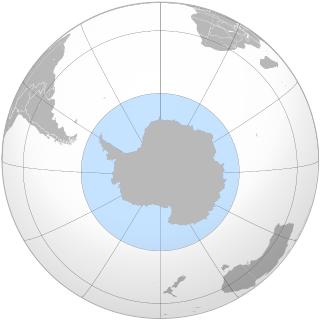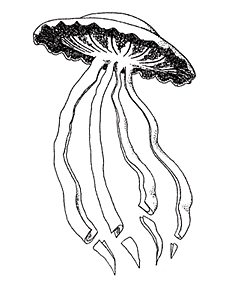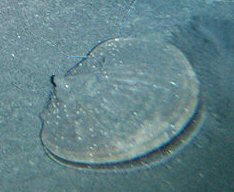
Hexactinellid sponges are sponges with a skeleton made of four- and/or six-pointed siliceous spicules, often referred to as glass sponges. They are usually classified along with other sponges in the phylum Porifera, but some researchers consider them sufficiently distinct to deserve their own phylum, Symplasma. Some experts believe glass sponges are the longest-lived animals on earth; these scientists tentatively estimate a maximum age of up to 15,000 years.

Gaussberg is an extinct, 370-metre-high (1,210-foot) high volcanic cone in East Antarctica fronting on Davis Sea immediately west of Posadowsky Glacier. It is ice-free and conical in nature, having formed subglacially about 55,000 years ago. The current edifice is thought to be the remains of a once-larger mountain that has been reduced by glacial and subaerial erosion. The volcano has produced lamproite magmas, and is the youngest volcano to have produced such magmas on Earth.

Mount Melbourne is a 2,733-metre-high (8,967 ft) ice-covered stratovolcano in Victoria Land, Antarctica, between Wood Bay and Terra Nova Bay. It is an elongated mountain with a summit caldera filled with ice with numerous parasitic vents; a volcanic field surrounds the edifice. Mount Melbourne has a volume of about 180 cubic kilometres (43 cu mi) and consists of tephra deposits and lava flows; tephra deposits are also found encased within ice and have been used to date the last eruption of Mount Melbourne to 1892 ± 30 years. The volcano is fumarolically active.

Mount Takahe is a 3,460-metre-high (11,350 ft) snow-covered shield volcano in Marie Byrd Land, Antarctica, 200 kilometres (120 mi) from the Amundsen Sea. It is a c. 30-kilometre-wide (19 mi) mountain with parasitic vents and a caldera up to 8 kilometres (5 mi) wide. Most of the volcano is formed by trachytic lava flows, but hyaloclastite is also found. Snow, ice, and glaciers cover most of Mount Takahe. With a volume of 780 km3 (200 cu mi), it is a massive volcano; the parts of the edifice that are buried underneath the West Antarctic Ice Sheet are probably even larger. It is part of the West Antarctic Rift System along with eighteen other known volcanoes.

Bridgeman Island is one of the South Shetland Islands. It is an almost circular, volcanic island marked by steep sides, measuring 900 by 600 metres with a maximum elevation of 240 m (787 ft) high, lying 45 kilometres (28 mi) east of King George Island.

Thwaites Glacier is an unusually broad and vast Antarctic glacier located east of Mount Murphy, on the Walgreen Coast of Marie Byrd Land. It was initially sighted by polar researchers in 1940, mapped in 1959–1966 and officially named in 1967, after the late American glaciologist Fredrik T. Thwaites. The glacier flows into Pine Island Bay, part of the Amundsen Sea, at surface speeds which exceed 2 kilometres (1.2 mi) per year near its grounding line. Its fastest-flowing grounded ice is centered between 50 and 100 kilometres east of Mount Murphy. Like many other parts of the cryosphere, it has been adversely affected by climate change, and provides one of the more notable examples of the retreat of glaciers since 1850.

Antarctica is Earth's southernmost and least-populated continent. Situated almost entirely south of the Antarctic Circle and surrounded by the Southern Ocean, it contains the geographic South Pole. Antarctica is the fifth-largest continent, being about 40% larger than Europe, and has an area of 14,200,000 km2 (5,500,000 sq mi). Most of Antarctica is covered by the Antarctic ice sheet, with an average thickness of 1.9 km (1.2 mi).

The Southern Ocean, also known as the Antarctic Ocean, comprises the southernmost waters of the world ocean, generally taken to be south of 60° S latitude and encircling Antarctica. With a size of 20,327,000 km2 (7,848,000 sq mi), it is regarded as the second-smallest of the five principal oceanic divisions: smaller than the Pacific, Atlantic, and Indian oceans but larger than the Arctic Ocean. Since the 1980s, the Southern Ocean has been subject to rapid climate change, which has led to changes in the marine ecosystem.

The colossal squid is the largest member of its family Cranchiidae, the cockatoo or glass squids, with its second largest member being Megalocranchia fisheri. It is sometimes called the Antarctic cranch squid or giant squid and is believed to be the largest squid species in terms of mass. It is the only recognized member of the genus Mesonychoteuthis and is known from only a small number of specimens. The species is confirmed to reach a mass of at least 495 kilograms (1,091 lb), though the largest specimens—known only from beaks found in sperm whale stomachs—may perhaps weigh as much as 600–700 kilograms (1,300–1,500 lb), making it the largest known invertebrate. Maximum total length has been estimated at 9–10 metres (30–33 ft). The colossal squid has the largest eyes of any known creature ever to exist, with an estimated diameter of 27 cm (11 in).

Stygiomedusa gigantea, commonly known as the giant phantom jelly, is the only species in the monotypic genus of deep sea jellyfish, Stygiomedusa. It is in the Ulmaridae family. With only around 110 sightings in 110 years, it is a jellyfish that is rarely seen, but believed to be widespread throughout the world, with the exception of the Arctic Ocean.

Odontaster validus is a species of sea star in the family Odontasteridae. Its range includes the Southern Ocean and the seas around the mainland and islands of Antarctica.

The Antarctic scallop is a species of bivalve mollusc in the large family of scallops, the Pectinidae. It was thought to be the only species in the genus Adamussium until an extinct Pliocene species was described in 2016. Its exact relationship to other members of the Pectinidae is unclear. It is found in the ice-cold seas surrounding Antarctica, sometimes at great depths.

Sterechinus neumayeri, the Antarctic sea urchin, is a species of sea urchin in the family Echinidae. It is found living on the seabed in the waters around Antarctica. It has been used as a model organism in the fields of reproductive biology, embryology, ecology, physiology and toxicology.

The wildlife of Antarctica are extremophiles, having adapted to the dryness, low temperatures, and high exposure common in Antarctica. The extreme weather of the interior contrasts to the relatively mild conditions on the Antarctic Peninsula and the subantarctic islands, which have warmer temperatures and more liquid water. Much of the ocean around the mainland is covered by sea ice. The oceans themselves are a more stable environment for life, both in the water column and on the seabed.
Cinachyra antarctica is a species of antarctic sponge belonging to the family Tetillidae. It was first described by H.J. Carter in 1872. A 2002 study in Antarctica calculated that this sponge and another antarctic sponge, Anoxycalyx joubini, have amazingly long lifespans surpassing 1,550 years in C. antarctica and 15,000 years in A. joubini. A. joubini lives in deeper waters than C. antarctica. Antarctic sponges have such lifespans, probably because of their surroundings, living at 100–2,000 m (330–6,560 ft) below the surface, at extremely cold temperature and constant pressure. This may slow down their growth rate and other biological processes, which has a remarkable lifespan as a result, because in a caught specimen of A. joubini did not show any growth in a span of 10 years. C. antarctica lives at the bottom, as a benthic, sessile creature. Complete specimens have large, visible pores and an overall yellowish appearance with hair-like structures covering some parts next to the pores, giving it the look of a giant virus. Caught specimens are usually incomplete and rarely measure more than 2.5–3 cm.
Urticinopsis antarctica is a species of sea anemone in the family Actiniidae. It is found in the Southern Ocean around Antarctica.
Mount Rittmann is a volcano in Antarctica. Discovered in 1988–1989 by an Italian expedition, it was named after the volcanologist Alfred Rittmann (1893–1980). It features a 2 kilometres (1.2 mi) or 8 by 5 kilometres wide caldera which crops out from underneath the Aviator Glacier. The volcano was active during the Pliocene and into the Holocene, including large explosive eruptions; a major eruption occurred in 1254 CE and deposited tephra over much of Antarctica. Currently, the volcano is classified as dormant.

Mount Berlin is a 3,478 metres (11,411 ft) high glacier-covered volcano in Marie Byrd Land, Antarctica, 210 kilometres (130 mi) from the Amundsen Sea. It is a c. 20-kilometre-wide (12 mi) mountain with parasitic vents that consists of two coalesced volcanoes; Berlin proper with the 2 kilometres (1.2 mi) wide Berlin Crater and Merrem Peak with a 2.5 by 1 kilometre wide crater, 3.5 kilometres (2.2 mi) away from Berlin. Trachyte is the dominant volcanic rock and occurs in the form of lava flows and pyroclastic rocks. It has a volume of 2,000 km3 (500 cu mi) and rises from the West Antarctic Ice Sheet. It is part of the Marie Byrd Land Volcanic Province.
Rossella antarctica is a relatively small species of glass sponge. It is widely distributed in the southern hemisphere, particularly in the Antarctic and sub-Antarctic regions.















